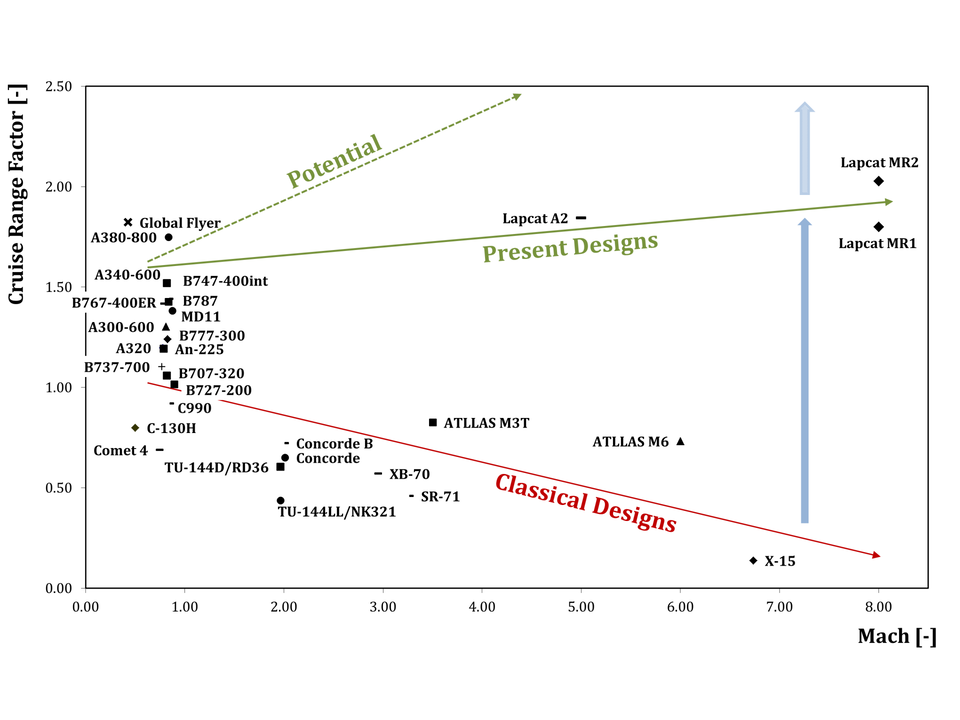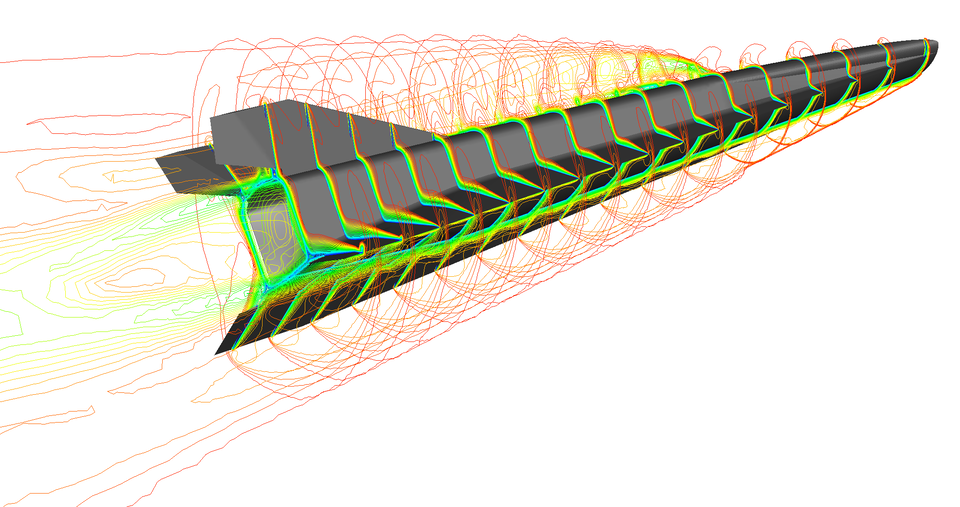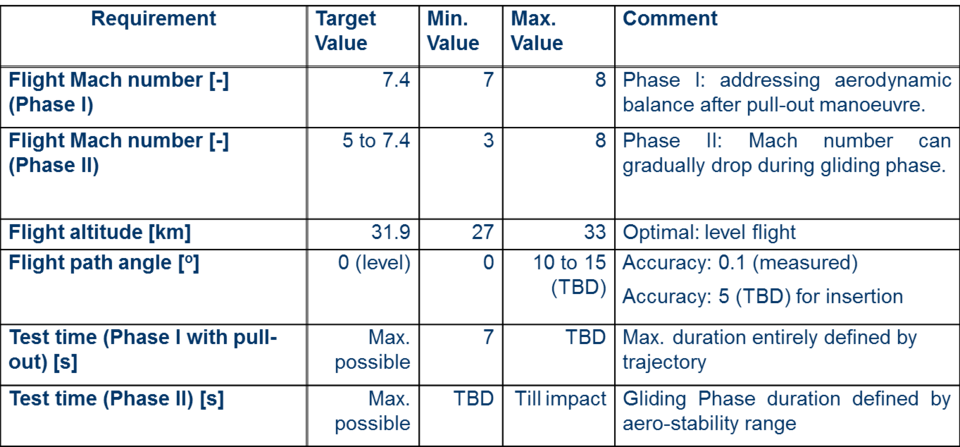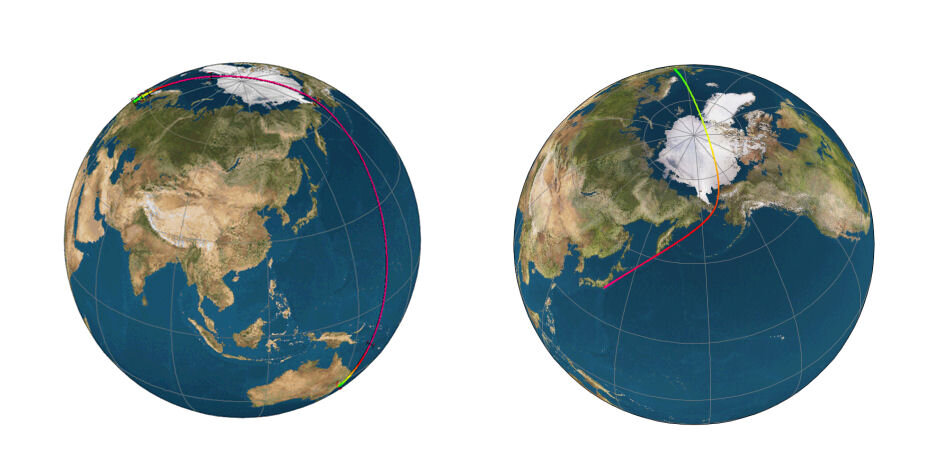High-Speed Experimental Fly Vehicles - INTernational
Imagine the flight time from Brussels to Tokyo could be less than 2hr 15 mins or Brussels to Sydney in less than 3 hours. This is the concept being investigated by ESA and its Partners.
Concept
Civil High-speed transportation has always been hampered by the lack of range potential or a too high fuel consumption stemming from a too low cruise efficiency. Over the last few years, however, radical new vehicle concepts have been proposed and conceived with a strong potential to alter this trend. This innovative approach is based upon a well elaborated integration of a highly efficient propulsion unit with a high-lifting vehicle concept.
The trajectories below show the ground tracks for flights from Brussels to Sydney and Tokyo respectively.
| Trajectory | Distance Flown [km] | Great Circle distance [km] | Total Flight Time | Fuel consumed [ton] | Fuel Remaining [ton] | TO mass [ton] | Consumed KgFuel/ 100km/ PAX |
| BRU-SYD[1] | 18,734 | 16,734 | 2h47 | 181 | 0.25 | 400 | 3.23 |
| BRU-SYD[2] | 18,734 | 16,734 | 2h42 | 171.75 | 9.5 | 400 | 3.06 |
| BRU-LAX[3] | 12,845 | 9,075 | 2h20 | 136.8 | 44.5 | 400 | 3.55 |
| BRU-NRT | 11,843 | 9,483 | 2h13 | 131.1 | 50.2 | 400 | 3.69 |
| BRU-NRT | 11,843 | 9,483 | 2h13 | 119 | 21 | 360 | 3.35 |
[1] Reduced subsonic cruise distance to 240 km.
[2] No subsonic cruise
[3] Full tank at take-off
This realisation of both high propulsive and aerodynamic efficiency is based upon the minimisation of kinetic jet losses while striving to the best uniformity but minimal induced velocity for lift creation. The dashed green line in image above illustrates the potential of this innovative design methodology. Looking into the performance of classically designed high-speed vehicles, their performances drop nearly linearly with flight Mach number as indicated by the red line on the image below. The green line indicates what has been achieved as a revolutionary, high speed civil air transportation concepts worked-out along this new approach.

Performing a test flight will be the only and ultimate proof to demonstrate the technical feasibility of these new promising high-speed concepts versus their potential in range and cruise. This would result into a major breakthrough in high-speed flight and create a new era of conceptual vehicle designs.
At present, the promised performances can only be demonstrated by numerical simulations or partly experimentally. As high-speed tunnels are intrinsically limited in size or test duration, it is nearly impossible to fit even modest vehicle planform completely into a tunnel. Therefore experiments are limited either to the internal propulsive flowpath with combustion but without the presence of high-lifting surfaces, or to complete small-scaled aero-models but without the presence of a combusting propulsion unit. Though numerical simulations are less restrictive in geometrical size, they struggle however with accumulated uncertainties in their modelling of turbulence, chemistry and combustion making complete Nose-to-Tail predictions doubtful without in-flight validation. As a consequence, the obtained technology developments are now limited to a technology readiness level of TRL 4 (components validated in laboratory).
General Objectives

HEXAFLY aims to create a multi-disciplinary platform where several breakthrough technologies can be mounted on board for testing in free flight at high speed. This approach will create the basis to increase gradually the Technology Readiness Level (TRL). The emerging technologies and breakthrough methodologies strongly depending on envisaged flight tests at high speed can be grouped around the 6 major axes:
- High-Speed Vehicle Conceptsto assess the overall vehicle performance in terms of cruise-efficiency, range potential, aero-propulsive balance, aero-thermal-structural integration, etc...
- High-Speed Aerodynamicsto assess aerodynamic vehicle shapes with high L/D (lift to drag ratio), aerodynamic manoeuvrability, stability, etc…
- High-Speed Propulsion to evaluate the performance of high-speed propulsive devices such as intakes, air-breathing engines (ABE), nozzles (SERN) including phenomena such as high-speed combustion, injection-mixing processes, etc…
- High-Temperature Materials and Structures to flight test under realistic conditions high temperature lightweight materials, active/passive cooling concepts, reusability aspects in terms oxidation, fatigue, etc…
- High-Speed Flight Control requiring real-time testing of GNC (Guidance Navigation Control) in combination with HMS/FDI technologies (Health Monitoring Systems/ Fault Detection and Isolation)
- High-Speed Environmental Impact focusing on reduction techniques for sonic boom and sensitivities of high-altitude emissions of H20, CO2, NOx on the stratosphere.
To mature a first flight testing campaign, a scientific mission profile has been worked out within a precursor Level 0 project called HEXAFLY followed by a proof-of-concept based upon:
- a preliminary design of a high-speed flight test vehicle covering the six major axes
- selection and integration of the ground-tested technologies developed within LAPCAT I & II, ATLLAS I & II and other national programs
- identification of the most promising flight platform(s)
which allowed addressing following items:
- identification of potential technological barriers to be covered in the follow-up project HEXAFLY-INT
- detailing the plan to work the project out in the HEXAFLY-INT project
- the progress and potential of technology development at a higher TRL
The vehicle design, manufacturing, assembly and verification will be the main driver and challenge in HEXAFLY-INTernational in combination with a mission profile. The prime objectives of this free-flying high-speed cruise vehicle shall aim for:
- a conceptual design demonstrating a high aerodynamic efficiency in combination with high internal volume
- a gliding flight at a cruise Mach number of 7 to 8 in a controlled way
- making optimal use of advanced high-temperature materials and/or structures
- an evaluation of the sonic boom
Once conceived, the aerodynamic performance from Mach 8 down to Mach 3 to 5 can be determined as a secondary objective. The overall mission requirements are listed in table below.

The level of complexity and the number of technologies to be potentially integrated largely depends on the affordable size of the flight vehicle. The presently available ground facilities within Europe limit the size to ~1.5m length whereas ~4.5m seems to be an upper limit stemming from presently on-going flight experiments. However, the trade-off study within HEXAFLY took into account the following issues:
- minimum needed internal volume to contain all necessary subsystems for a free-flying vehicle
- a modest financial envelope for hypersonic flight testing
- the know-how and expertise acquired recently through the German SHEFEX-I/II projects and the Italian USV project
- the affordable launchers presently available,
- the existing databases generated within ATLLAS I/II and LAPCAT I/II
- the high altitude expertise and related flight control acquired in flight during the SHEFEX II flight and FAST20XX
- the availability of large test facilities for risk-reduction resulted finally into a most promising choice of a ~3m long flight vehicle.
Besides the high-speed flight experiment, an additional flight experiments will be performed to cross-check the viability of the vehicle concept for later deployment as passengers aircraft i.e.:
- low-speed flight experiments in the Marulan test site (Univ. of Sydney) to verify the take-off and landing potential of the waverider based vehicle
The duration for this project is set forward such that the international team i.e. Europe, Brazil and Australia, can complete the following major steps:
- define the requirements and operational conditions for the scientific mission;
- perform a detailed layout of a flight vehicle able to test technologies along the major axes;
- define the required flying platform with the needed adaptations;
- carrying out extensive on-ground tests and numerical simulations to reduce uncertainties and risks; preferably on full-scale flight representative models;
- manufacturing the experimental flight test vehicle along with the needed adaptations to the launcher;
- assembling, integrating, verifying and testing the experimental payload and the related launcher;
- carry out the flight experiment and collect the data;
- perform a post-flight analysis;
- disseminate the results.
Besides the vehicle and platform definition, the suitability of the launch site and test range was assessed in terms of potential limitations on the mission and scientific objectives, i.e. flight corridors, TTC (telemetry, tracking and command), safety aspects (termination) and recovery. So far, the Alcântara Space Center in Brazil was selected as the launch site.






